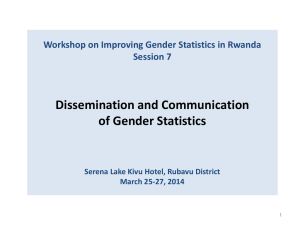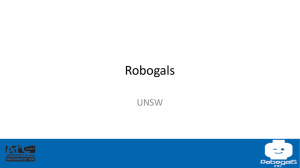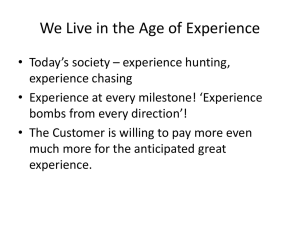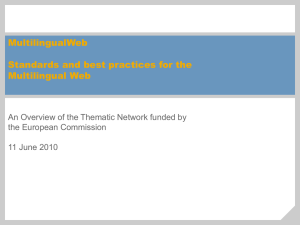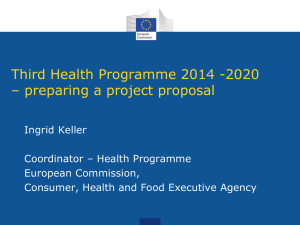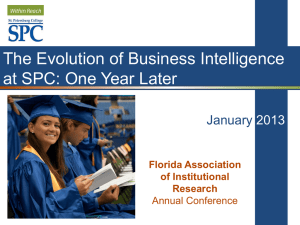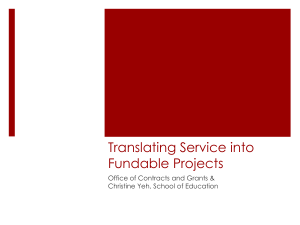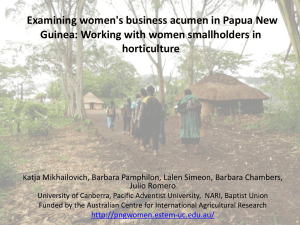Editable Intel® Education powerpoint template
advertisement
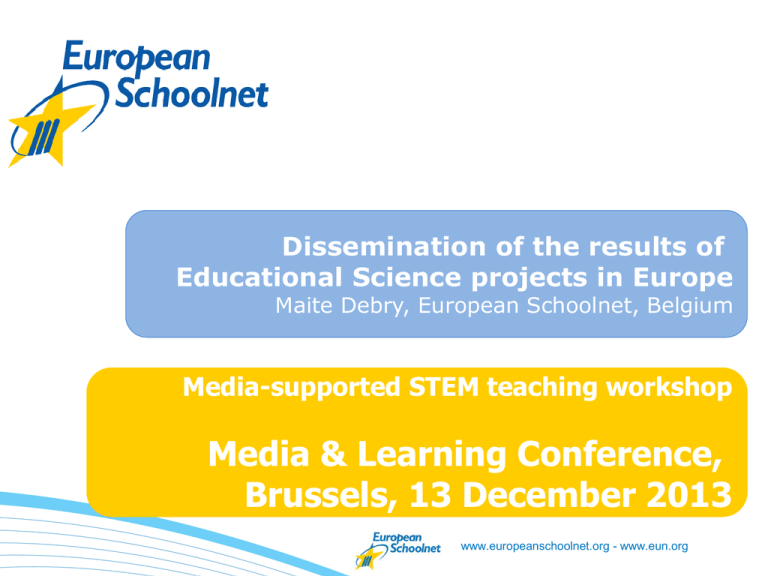
Dissemination of the results of Educational Science projects in Europe Maite Debry, European Schoolnet, Belgium Media-supported STEM teaching workshop Media & Learning Conference, Brussels, 13 December 2013 www.europeanschoolnet.org - www.eun.org European Schoolnet (EUN) Promoting the use of ICT and digital technologies in the classroom Network of 30 Ministries of Education in Europe Promoting the European dimension in schools Improving the quality of education in Europe Three areas of interest: services to schools, research and innovation, sharing of learning resources www.europeanschoolnet.org - www.eun.org EUN STEM Projects www.europeanschoolnet.org - www.eun.org EUN STEM Projects www.europeanschoolnet.org - www.eun.org 4 European science and maths projects www.europeanschoolnet.org - www.eun.org Disseminating Educational Science, Innovation and Research in Europe How do funded science education projects disseminate their outcomes to target audiences? Analysis of the current status for more effective dissemination www.europeanschoolnet.org - www.eun.org Problem and Research Questions "The dissemination of research findings has been given increasing emphasis in recent years, particularly in the wake of critiques of educational research for failing to have an impact on policy-making and practice“ (Hammersley, 2000) What are we looking for? • How are the outcome from science education projects disseminated to target audiences? – Current status • What recommendations do different target groups suggest to improve the dissemination strategies used in science education projects? - Recommendations www.europeanschoolnet.org - www.eun.org What models of dissemination have been described to bridge the academicpractitioner gap? www.europeanschoolnet.org - www.eun.org What do we understand by dissemination? • Dissemination of results understood as the diffusion of innovations are envisaged as “the process in which an innovation is communicated through certain channels over time among the members of a social system”, undergoing different phases, such as awareness, understanding, persuading, adopting (or rejecting), and re-inventing (Rogers, 1983 – On social sciences) • We will refer to dissemination as the process by which, using certain strategies and channels, outcomes of a project are made available, comprehensible and usable to be adopted by potential users (Harmsworth et al., 2001 – On educational development projects) www.europeanschoolnet.org - www.eun.org Methodology INSTRUMENTS OF DATA COLLECTION Survey for project managers Survey for teachers Survey for policy-makers Closed-ended (Multiple choice, matrix of choices, 5-points Likert scale) Open-ended questions CONTACTED SAMPLE: 46 FUNDED R+D SCIENCE EDUCATION PROJECTS 20 projects funded within 7th FP 18 projects funded within LLP 6 projects funded by national institutions 2 projects funded by other organisms Pilot test of the surveys COLLECTED DATA 26 responses from project managers about 26 projects 105 responses from teachers about 21 projects 15 responses from policy-makers about 10 projects www.europeanschoolnet.org - www.eun.org Methodology INSTRUMENTS OF DATA COLLECTION Online & face-to-face discussion events DATA ANALYSIS Qualitative analysis intended: - To interpret connections among dissemination strategies and outcomes to be disseminated or target audiences - To identify possible differences among projects funded by different funding sources - To identify target audiences’ needs regarding dissemination www.europeanschoolnet.org - www.eun.org Results On the channels / strategies to disseminate project outcomes Paper-based channels Web-based channels Face-to-face events The dissemination channels / strategies used by project managers depend on the type of project outcome intended to be disseminated Teaching and learning materials Theoretical or empirical research findings Network of people www.europeanschoolnet.org - www.eun.org Results On the dissemination channels to reach each target audience Most project managers recognise that the way project outcomes are communicated is adapted for different stakeholders. Teachers Policy-makers Project managers / Researchers All target audiences recognise that other channels through which they usually get informed are e-mails, brief documents and social media, although it does not seem that project managers prioritize it. www.europeanschoolnet.org - www.eun.org Results On the criteria used to evaluate the effectiveness of dissemination Citation index of published articles 2 Quality of the dissemination strategies as perceived / evaluated by the target audience 10 Number of users (i.e. number of people using the project results) 11 Number of reached people (e.g. attending / participating in an event, downloading a material, visiting a website) 16 0 2 4 6 8 10 12 14 16 18 20 The criteria for evaluating the effectiveness of dissemination dilemma between quality and quantity. Some project managers: worries about scaling up and reaching a larger audience. Other researchers: more concerned about the quality of relationships with teachers and policy makers www.europeanschoolnet.org - www.eun.org Results Stakeholders’ perception of the amount of information reached from science education projects www.europeanschoolnet.org - www.eun.org Results On the needs or difficulties to disseminate / reach science education projects’ outcomes Specific needs for dissemination Project managers Teachers Policy makers Time constraints 25% 34% 40% Resource constraints (e.g. funding, technology, human) 11% 22% 20% Lack of active involvement of the target audience 35% 38% 36% Underuse of already existing resources or networks 34% 50% 18% Low reach of the target audience (i.e. number or variety) 14% 25% 30% Language barriers - 26% 50% Barriers related to the style of dissemination channels - 26% 20% Lack of support from partners in the project - 18% - Lack of support from colleagues in one’s own context - 44% - www.europeanschoolnet.org - www.eun.org THE MAIN GOALS ARE TO: - Provide information about targets of STEM education project - Identify obstacles - Give tools to create a multiplier effect and eventually mainstreaming results into policies - Highlight approaches which can federate existing initiatives and point to key European or national services www.europeanschoolnet.org - www.eun.org www.europeanschoolnet.org - www.eun.org Recommendations from stakeholders on how to improve dissemination strategies Stakeholders’ needs Recommendations Time constraints Projects devoted to produce outcomes might be followed by projects specifically addressed to disseminate and exploit those results Resource constraints (e.g. funding, technology, human) Incentives (e.g. remuneration, recognition, training, equipment for school) should be provided to teachers and other stakeholders so that they engage in reaching and using projects’ outcomes Lack of active involvement of the target audience Stakeholders should be involved as intermediaries, ambassadors or members of an steering committee from the beginning of a project to act as multipliers at a regional/national level Underuse of already existing resources or networks Strong contact and cooperation should be established with local teacher training institutions and programmes, reference centres, databases (e.g. Scientix), and networks addressed to similar topics (e.g. ProCoNet). New teachers’ networks should be potentiated after the end of a project for scaling up Low reach of the target Mass media (e.g. newspapers), social media and social networks (e.g. local audience (i.e. number or and international) should be used more often in order to have a larger impact variety) among teachers. Conferences, seminars and workshops are one of the best ways to gain new knowledge and inform teachers and policy makers about projects. www.europeanschoolnet.org - www.eun.org Recommendations from stakeholders on how to improve dissemination strategies Stakeholders’ needs Recommendations Language barriers Dissemination materials should be provided in other languages than English and more dissemination initiatives (e.g. conferences) should be organised at a local or regional level Barriers related to the style of dissemination channels Projects should document experiences and present them in a flexible way (e.g. case studies, scripts for teachers, movies of educational activities, evidence-based books for teachers) in order to spread good practice and generate adaptive processes so that stakeholders can learn from past experiences. Brief and concise messages may facilitate the communication between researchers and other stakeholders. The usability of some dissemination channels (e.g. websites) should be improved so that people do not get lost Lack of support from partners in the project Guidelines and support should be provided to stakeholders so that they can use what has been disseminated. These guidelines should take account of the curriculum, school organisation, teachers’ current practices, etc. Lack of support from colleagues in one’s own context Local consulting commissions should be developed involving teachers, researchers, students’ families, school principals and administrators, and other relevant actors www.europeanschoolnet.org - www.eun.org Conclusions • Most of the models of dissemination currently used in funded projects on science education seem to combine channels and strategies characteristic of traditional linear models and social constructivist models (e.g. wide use of reports, websites and conferences as dissemination channels, face to face participatory techniques to interact with stakeholders). • Recommendations from stakeholders tend to advocate for dissemination models which assume wider involvement of stakeholders and already existing institutions and networks as intermediaries with an active role in dissemination actions, which is characteristic of the sustained interactivity model. At the same time, stakeholders recommend to take account of contextual factors influencing dissemination, stressing the need for overcoming language barriers, aligning the outcomes with curriculum, school organisation, and teachers’ current practices, organising local consulting commissions, etc. These recommendations are also consistent with the Mode 2 knowledge model. www.europeanschoolnet.org - www.eun.org http://scientix.eu http://scientix.eu & maths & engineering & technology Primary and Secondary (4 – 21 years old) Scientix 1: 2010 - 2012 Conference 2011 Portal Workshops Scientix 2: 2013 - 2015 Conference 2014 Portal (disseminate projects) Workshops Scientix 2: 2013 - 2015 Scientix National Contact Points & Teachers’ panel Promote collaboration between projects Scientix observatory Scientix 2: 2013 - 2015 Portal (disseminate projects) Collaboration between projects Conference 2014 Workshops Scientix observatory National Contact Points & teachers’ panel Scientix 2: 2013 - 2015 Portal (disseminate projects) Collaboration between projects Conference 2014 Workshops Scientix observatory National Contact Points & teachers’ panel Scientix 2 European Conference 24- 26 October 2014, Brussels • Key note speech • Posters session • Talks • Round tables • 25 stands presenting EU funded projects • Workshops • BUT this time… 2 Scientix 2 European Conference 24- 26 October 2014, Brussels • Key note speech • Posters session • Talks • Round tables • 25 stands presenting EU funded projects • Workshops • BUT this time… 550 participants • AND EUN will be covering: • hotel accommodation for all • 200 flights for teachers http://scientix.eu 2 Scientix 2: 2013 - 2015 Portal (disseminate projects) Collaboration between projects Conference 2014 Workshops Scientix observatory National Contact Points & teachers’ panel Online training… …and Scientix workshops Scientix workshops Scientix 2: 2013 - 2015 Portal (disseminate projects) Collaboration between projects Conference 2014 Workshops Scientix observatory National Contact Points & teachers’ panel Promote collaboration between projects 1. Project managers meetings / workshops (1 – 3 times a year). First one 27 – 29 Nov 2013 2. Scientix offers online meeting room 3. Scientix workshops Project workshops Scientix 2: 2013 - 2015 Portal (disseminate projects) Collaboration between projects Conference 2014 Workshops Scientix observatory National Contact Points & teachers’ panel Scientix observatory Scientix 2: 2013 - 2015 Portal (disseminate projects) Collaboration between projects Conference 2014 Workshops Scientix observatory National Contact Points & teachers’ panel Scientix National Contact Points http://scientix.eu @scientix_eu THANK YOU VERY MUCH FOR YOUR ATTENTION For further information: DESIRE http://desire.eun.org European Schoolnet, Project Manager - Maïté Debry: maite.debry@eun.org Scientix http://scientix.eu European Schoolnet - Science Programme Manager // Scientix project manager Àgueda Gras-Velázquez, European Schoolnet, Brussels, Belgium agueda.gras@eun.org www.europeanschoolnet.org - www.eun.org
